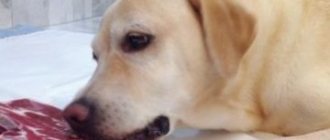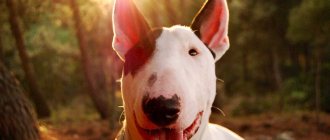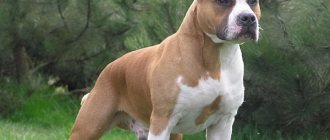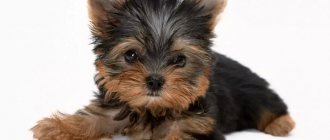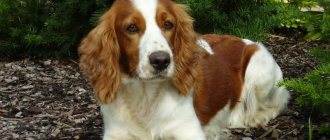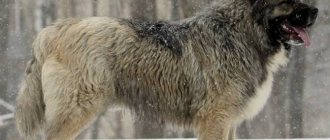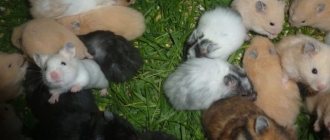Labradors are one of the most kind and sociable dog breeds
By nature they tend to be lazy, but they love activity. The breed was developed in England in the 19th century and is considered a hunting breed . Proper education of a Labrador puppy is the key to an obedient dog in the future.
If you just want a big furry friend, then a Labrador is the perfect candidate.
Given the rather large size of the dog ( at the withers they reach 60 cm and weigh up to 40 kg) , they live well not only in their homes, where enclosures are built for dogs, but also in apartments.
The Labrador gets along well with children and is ready to be a friend to every person, but we will tell you how to choose the right Labrador puppy below. If you choose a Labrador as a pet, it is worth remembering some of the characteristics of the breed.
Advice! If we talk about the fertility of this breed, then, as a rule, there are 5-6 puppies, but sometimes ten are born - it depends on genetics.
If you take responsibility for the dog you want to breed, then it is worth remembering that even small dogs of a large breed are capable of destroying a home, just like adult animals.
Care and feeding of Labrador puppies
For the first four weeks, the puppies are fully cared for by the mother . The dog feeds the babies and licks them. It is important to monitor the condition of a nursing dog, give it enough food and keep the area where it lives with puppies clean. Until Labradors are a month old, they do not require additional nutrition.
Let’s look at what to feed a Labrador puppy from the second month onwards. The first food is given to retrievers at four weeks of age. This is a special food for puppies , diluted to a porridge state and heated to a temperature of 38° .
From 6 weeks, puppies are given in solid form . While the dog is feeding the babies, complementary feeding is done 3 times a day.
How to care for a Labrador puppy when you get it from a breeder, it is important to remember that you need to feed it five times a day. Food for a Labrador puppy is preferably dry, soaked in kefir, cottage cheese, milk porridge, finely chopped meat (beef, chicken, lamb), boiled vegetables, raw offal.
Important! So that the kitten does not overeat and does not swell like a balloon after eating (it should round up a little).
Eggs are also given, but only the yolk (once a week). At the age of 4 months they switch to three meals a day (we remove the afternoon snack).
Until the age of 8 months, the pet is given bones. From the age of 9 months to a year, a dog eats 700 grams of meat , and after a year - 0.5 kg per day.
Feeding natural food or dry food is a question that is decided individually. The main thing in caring for a Labrador puppy is to provide it with the necessary vitamins .
Dogs should not be given sweets, table scraps, peels, or small bones.
Table of Labrador puppy weight changes by month
| Age | Weight, kg) | Height at withers (cm) | Chest (cm) | Head circumference (cm) |
| 1 month | 3,3 – 3,8 | 22 – 24 | 36 – 38 | 27 – 28 |
| 2 months | 7 – 8 | 30 – 33 | 45 – 55 | 28 – 32 |
| 3 months | 11,5 – 14 | 38 – 42 | 51 – 55 | 33 – 36 |
| 4 months | 16 – 19 | 43 – 46 | 57 – 64 | 37 – 39 |
| 5 months | 21 – 22,5 | 47 – 51 | 65 – 68 | 40 – 42 |
| 6 months | 24 – 26 | 50 – 54 | 67 – 70 | 42 – 43 |
| 7 months | 25,5 – 28 | 52 – 56 | 69 – 74 | 43 – 44 |
| 8 months | 27,5 – 30 | 54 – 58 | 70 – 75 | 45 – 46 |
| 9 months | 29,5 — 32 | 55 – 58 | 71 – 77 | 45 – 48 |
| 10 months | 29 – 36 | 55 – 59 | 70 – 83 | 46 – 52 |
| Adult dog | 30 – 40 | 53 – 60 | 70 – 85 | 46 – 56 |
Please remember that the figures are approximate . You need to look at the general well-being of the puppy and do not forget to show him to the veterinarian.
Character
In ancient times, Labradors were used for hunting; the dog perfectly tracks down game and brings it from different places.
Labradors especially love water. Nothing will help get the little fluffy out of the warm pool, except a piece of his favorite treat. Labradors are attached to their owner and family, and from childhood the dog prefers the role of a subordinate. This is not a selfish dog; if necessary, it will share food with loved ones. The Labrador rejoices at every little thing, and the joy is manifested in the constant wagging of its tail. The mentioned feature of dogs of the breed often leads to chaos in the apartment. The Labrador breed is a loyal, kind, reliable and affectionate pet of the canine family.
A Labrador puppy can be safely adopted into a family where children and other pets live. A puppy, and then an adult dog, will never harm the latter.
The only drawback is that it is impossible to make a Labradorite into a human protector and apartment guard. The dog will not bite anyone, except to scare them by barking.
Breed standards
Labradors are dogs that are taller than average, have a compact build, and have a voluminous head. The average height of males is 57 cm, females - 56 cm. The chest is of increased size, the paws are powerful and straight. Medium sized teeth. The eyes on the head are set evenly, of medium size, the look of a Labrador is good-natured and friendly. The ears are soft, light, hanging down. The tail is long, thick at the base, gradually tapering towards the tip.
The coat is short, thick, the hair is straight; in retrievers, wavy hair is allowed. Color varies from white to blue-black.
Raising a Labrador Puppy
If you have adopted a two-month-old puppy, then the question arises: how to toilet train a Labrador puppy . If your home has linoleum or tiles on the floor, then the constant puddles left by the Labrador are not scary for him. If the floor is parquet, cover it with durable film or oilcloth. Puppies usually go to the toilet after eating or when they wake up .
Give your baby a tray in which you can crumble some newspaper. Place it near the tray when he has eaten or just woke up. After successful landings and praise, the dog will understand that it needs to go to the toilet there. But the tray is relevant until you have been vaccinated.
After completing the incubation period (approximately three months), the puppy begins to be taken outside. At first, the retriever will not understand that he must go to the toilet on the lawn in the yard, but will patiently wait for the litter box in the apartment.
To confuse your dog, take soaked newspapers with you on walks. The puppy will smell the scent and perhaps understand. If not, then gradually increase the walking time and carry newspapers with you.
Advice! Then the dog can’t stand it and goes to the toilet. Give away a tasty product for your efforts. He will remember this.
Thus, the child is gradually accustomed to using the toilet outside. If at the age of 6 months the puppy categorically does not understand that the toilet should be outside, contact the breeder or trainer - they will tell you what to do. But such situations rarely arise. Usually, by the age of 6 months, the dog is accustomed to endure and ask to go to the toilet on its own.
Have pity on the ceremonial suit
Education and training are very close concepts. However, the second applies more to a dog that is already undergoing obedience training or acquiring some kind of working specialty. And education is some general rules that include the most basic skills:
- knowing your nickname;
- a designated place for the toilet;
- calm attitude towards the collar and leash;
- knowledge of the prohibition command;
- understanding the territory allowed for walking.
Often, ill-mannered dogs pick up food from the ground or beg from the table, annoying guests. It’s really bad when the dog doesn’t even know his place in the house and hangs around wherever he can. The result of the owner's negligence may be the pet's childhood habit of chewing shoes or tearing laundry off the lines in the yard.
To prevent anything like this from happening in the future, the owner of a Labrador Retriever must always remember: the funny puppy will grow up very soon. And everything that causes tenderness in childhood can later become a serious problem. After all, there is little joy in the fact that when you meet a loving dog weighing 50 kg, he puts his dirty paws on your chest, ruining your expensive clothes.
The main rule: decide what your dog will be allowed to do when he grows up. Based on this, build a pet training program.
Labrador Puppy Training Basics
Labrador is a smart breed of dog , always ready to play and learn. If your puppy does something correctly during training, praise him. Call the retriever by name , and do this before each feeding, when you call, and also when you play.
In a few days the baby will begin to respond to the name . Give him a treat because he came running to you when he heard his name.
Also, the puppy should be one of the first to remember and know the commands “Place!” and “Come to me!” - the first will teach him to sleep not in your bed, and the second will help him on walks. When your pet falls asleep anywhere, you need to take him to the place where you have determined the place to sleep and rest, repeating the command. It needs to be repeated when he wakes up.
Advice! It is also worth putting an old pillow or blanket in this place of the room so that the puppy gets used to it and comes to the smell. After a while, when you repeat the command, he will understand you and come where you need to go. Appreciate his efforts out loud and give him a treat.
Command “Come to me!” It is spoken briefly and strictly , but without shouting. When the puppy (even if he doesn’t understand what they want from him) runs up to you, praise and treat him. After a few times he will understand and, hearing the command, will run to you for a treat.
Team "Ugh!" It is necessary that the dog, while walking along the streets, does not eat everything that is lying on the asphalt. You need to train it by placing a ball of dry food in front of the dog. The puppy reaches for food, you slap him on the nose with a rolled-up newspaper.
Important! Do not shout at the dog or hit it - this is prohibited. Simply hold the newspaper up to the dog's nose without actually smacking it.
Say the command at the same time. Reach again, repeat. After a while, the little Labrador will realize that if he reaches for something and hears “Ugh!”, he can’t take that object , something will land on his nose. It is important to teach this command , since in parks they often put poison for dogs, and the animal should not pick up anything.
How to accustom to a home environment
In order for a brown Labrador puppy or any other puppy to feel comfortable, you should follow some steps:
- give him the opportunity to walk around the house, look and smell everything around him;
- It is not recommended to suddenly change the puppy’s usual diet; at first it is worth providing him with his usual food;
- When whining at night in the first days in a new place, there is no need to accustom him to your bed; it is enough to stay next to him on his bedding and hold your hand on the puppy;
- Give your baby toys and allocate some time for learning from the first days.
Important! To build a trusting relationship with a pet, the owner should not lock the dog and cause him inconvenience. After all, the puppy has a good memory and immediately understands the owner’s mood.
Vaccinations for Labrador puppies are required!
By the age of two months, a Labrador is scheduled for its first vaccination . Or vaccination is carried out a little earlier, when babies are weaned from the dog (at one and a half months).
Ten days (or two weeks) they are given anthelmintic drugs. If you are planning to go for vaccination and your puppy is sick, postpone the trip.
Important! Re- vaccinate after three weeks . On the issue of vaccinations, the most important thing is not to forget to do them and consult a doctor or breeder on the slightest questions. But vaccinations are absolutely necessary.
The third vaccination is done when the dog is about a year old . And then they are vaccinated once a year. to the veterinarian for preventive examinations once every six months.
The dog also needs to periodically wormed and treated for fleas and ticks . Specific medications are prescribed by a veterinarian.
Development by day in the first month
Every day after the puppy is born, there is an increase in weight. In the first month, approximately 100-150 g per day.
From days 1 to 14, newborn puppies can only crawl and suckle at their mother's breast, gradually their sense of smell develops, and they independently try to find their mother.
It is necessary to closely monitor the puppies' temperature and avoid hypothermia when the body temperature drops to 34 degrees Celsius. If the puppies have a low temperature, they should be warmed up immediately on your chest. This method is the most effective and correct.
From 15 to 30 days, puppies open their eyes, a noticeable reaction to light, sounds, and nearby movement. At this time, animals begin to go to the toilet on their own and their teeth are cut. Dogs are becoming more and more active, starting to crawl and even run.
From days 21 to 30, the puppy begins to recognize the people around him. During this period, you need to especially carefully protect the puppy’s safety: it is forbidden to make loud noises, as this can negatively affect the pet’s condition. During this period, small Labradors learn the behavioral patterns of dogs.
Groundbait is introduced, which can cause small Labradors to experience diarrhea; this is a normal phenomenon, as they find it difficult to tolerate changes in diet. This should not be a cause for concern as long as the color and smell of the discharge does not change.
IMPORTANT!
If there are changes in the smell and color of the discharge, treatment must be started immediately. For this purpose, special medications are suitable to help normalize the functioning of the gastrointestinal tract.
Retriever bathing
Labradors are water lovers . They are famous as lifesavers at sea. Therefore, be prepared to catch your dog swimming or lying in a puddle when walking with it without a leash. If there is a pond with clean water near the walking areas, then let the dog out for a swim . If the animal has bathed in mud, then it is washed from head to toe with a special shampoo. If the animal avoids puddles, then bathing is carried out once every 4 to 6 months.
Advice! Wash your dog's paws and belly after every walk. Brush the dog every day or every other day.
The touchy-feely are being re-educated.
Labrador is a very active breed. For good physical development, the puppy must exercise a lot. As he grows up, walks will provide an outlet for energy and keep his muscular core in the right shape. It is important that the dog learns how to behave in the company of people and animals. Then he will not create problems for you either in an open field or on city streets.
These issues can be easily resolved with the help of a collar and leash. The baby should also be accustomed to them gradually. First, a soft collar is put on him for a very short time. Not too tight or loose. Two fingers should fit freely between it and the pet’s neck.
Most often, he will not pay any attention to the fact that something is wrong with him. However, there are some Labradors who are touchy-feely, who express dissatisfaction and try to remove the extra item with their paws. In any case, after you put the collar on your puppy, you need to give him a treat and distract him with play. Gradually, the period of time in the collar should be increased. The time will come, and the dog will stop reacting to him altogether.
Basic rules for handing over a puppy to a new owner
Weaning from the mother occurs gradually, over a couple of weeks . The amount of food for dogs is gradually reduced, and for puppies, on the contrary, the amount of complementary food is increased. Young retrievers are taken from their mother at two months .
first day in your home should be spent sleeping and constantly feeding. It’s worth spending the whole day with the baby, hugging him, calling him by name. The dog will begin to get used to you immediately. But don't make noise or invite guests to admire your new pet.
Provide your Labrador with a corner for sleeping where there is no draft. Put a box, a blanket, a toy there. The dog will soon try all this out. If your puppy whines, sit with him until he falls asleep.
Important! Do not take the animal to bed unless you plan for the retriever to sleep there for the rest of its life, as this habit is instilled immediately.
With any small animal you need to be affectionate, constantly communicate and pay attention, then the adaptation period will pass painlessly, and the puppy will get used to it faster.
A little background about the properties of the rock
Labradors have been helping humans fish and hunt game for over 1,000 years. The debate about their color has lasted for the same number of years. Black, chocolate or fawn? In litters, starting with the progenitors of the breed, descendants of three colors were born. Therefore, the choice of a puppy depends only on personal preferences or a gift of fate , which will manifest itself in the fact that a 1-2 month old baby will choose you.
Describing the character of the breed, we will highlight its friendly disposition, agreeableness, desire to be close, desire to serve, and willingness to work shoulder to shoulder. And a constant desire to eat. No one has ever seen a well-fed Labrador. Dog owners say they break into a cold sweat when they think they've run out of food.
Puppies have a difficult time learning security skills, but they are easy to train to work as a rescuer, assistant, hunter, fisherman or detective.
Introducing complementary foods
The first complementary foods are given to puppies after teething. This is a soaked specialized dry food or homemade diet.
Both of these options have their pros and cons, and professional breeders differ in their preferences. Expert opinion
Tolkachev Andrey Mikhailovich
veterinarian
I do not consider ready-made balanced foods, because I believe that any artificial mixture differs from “live” natural products. And the point here is not in the composition or selection of certain ingredients. Ultimately, you can choose any composition of proteins, fats and carbohydrates with vitamins and microelements, but it is impossible to guarantee the biological activity of the components of a freeze-dried (canned) product and their corresponding effective absorption, digestibility and utilization.
The puppy should be active and cheerful, with a good appetite and regular bowel movements. Any changes in the animal’s well-being and behavior - lethargy, refusal to eat, nausea, vomiting, diarrhea - require consultation with a veterinarian!
How to train and what commands to teach?
Training a puppy involves teaching basic commands:
- place;
- to me;
- ugh;
- sit;
- lie;
- give me your paw;
- voice;
- stand;
- fetch;
- front;
- near.
The dog learns each command only through encouragement; under no circumstances should you use physical force or shout. You should start with a nickname and leash training.
Cleaning teeth, ears and trimming nails
First, you need to carefully examine your ears and teeth for inflammation or infections.
To clean your ears, you can use cotton wool, gauze, cotton pads, cotton swabs or special wipes.
You can brush your teeth yourself by wrapping your finger in gauze or a bandage, or with a special brush. You can also use teeth cleaning products purchased at a pet store.
As for trimming claws, if the owner does not have sufficient experience, it is better to contact a specialist. In any case, you need to buy special tweezers for cutting.
Reproduction
The first thing you must understand and learn: only breeding representatives of the breed can participate in breeding, in accordance with the breeding plan drawn up in the kennel club. If you have purchased a pet-class dog, it is better to sterilize it immediately
The common belief that a dog needs to be mated at least once in its life “for health” is a harmful myth. Having untied the male, you will have to provide him with regular matings, and this is reasonable only if the male is good enough in terms of breed. A castrated male does not suffer at all from the absence of testicles; he retains a lively and energetic character and mobility. But he does not suffer from hormonal storms when a female dog in heat appears in the area, is free from the associated stress and lives longer. Males are sterilized after reaching physiological maturity.
A spayed female dog is guaranteed not to breed accidentally and will also not develop pyometra or ovarian cancer. The absence of heat will make the dog calmer and your apartment cleaner, since the heat of this breed can be quite abundant and leaves marks throughout the house. Sterilization, like mating in Labradors, occurs after 2 years, when the dog’s body is already fully formed.
If your bitch belongs to the breeding class, and you intend to breed her in order to produce puppies, then be prepared for the subsequent renovation of the apartment. Labrador retrievers usually give birth to 5 to 10 puppies, and these little terminators can turn the most well-kept apartment into something completely obscene.
The first heat in Labrador bitches occurs at the age of 8 months to one and a half years, but mating is carried out only at 2-4 heats. During this time, you will already have time to decide whether to breed or sterilize the dog.
When to wean from the bitch?
Labradors are large, often multiparous dogs.
If there are many puppies in the litter or the bitch has little milk, then it is often necessary to wean early, at 21-25 days. If there is enough milk, the puppies can continue to suckle their mother for up to 1.5–2 months.
If the bitch had a caesarean section, was treated with antibiotics or on the recommendation of a veterinarian, the puppies may be weaned earlier.
Exercise stress
Labrador is an active and lively dog; puppies of this breed grow quickly, and in order for the baby to develop normally, he needs to walk for at least two hours every day, and also visit the training area.
If there is insufficient load, a growing baby Labrador, like a Cane Corso puppy , begins to spoil and chew things, make tunnels, and dig holes in the yard.
The ebullient energy must be given an outlet, but it is impossible to overload the Labrador by jogging behind the bicycle.
Willy-nilly, you smile while looking at a happy Labrador puppy running
A four-month-old puppy can already visit the training area and walk with the owner for an hour or two.
It is useful to walk up the stairs or up the mountain (but go down either by another route, or carry your Labrador in your arms).
Swimming in open water, running in shallow water - all this is very popular with Labrador babies, it strengthens their muscles and promotes proper development.
